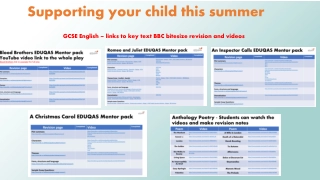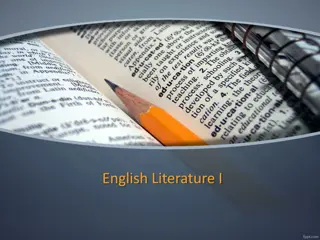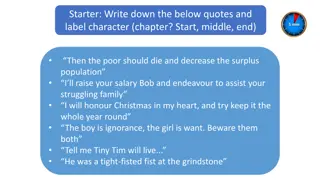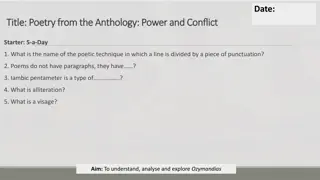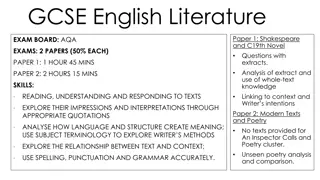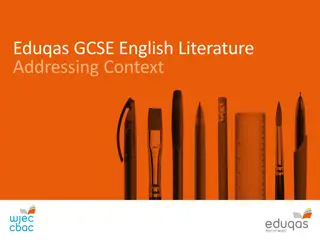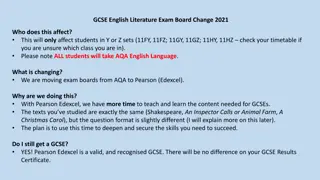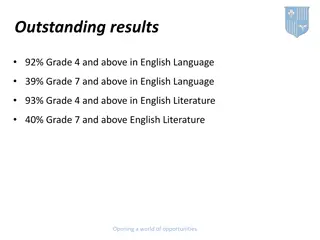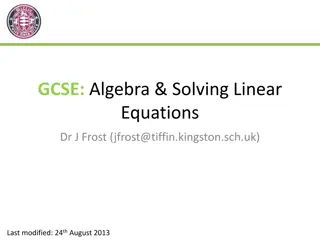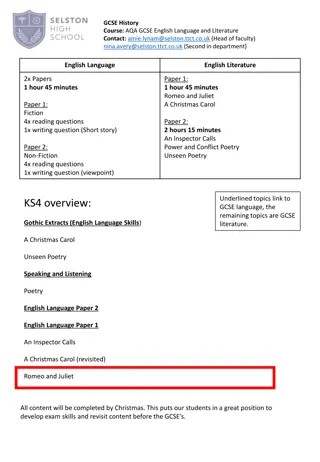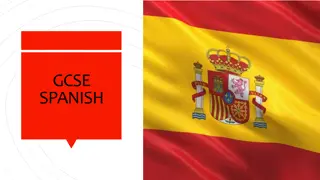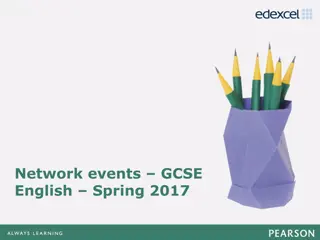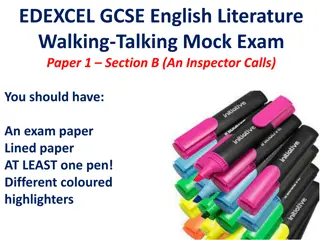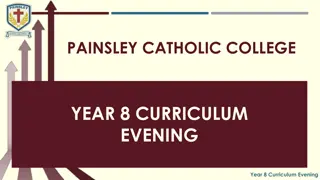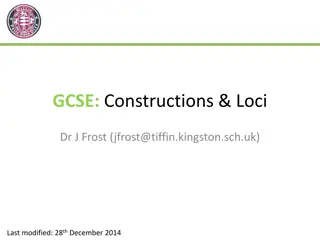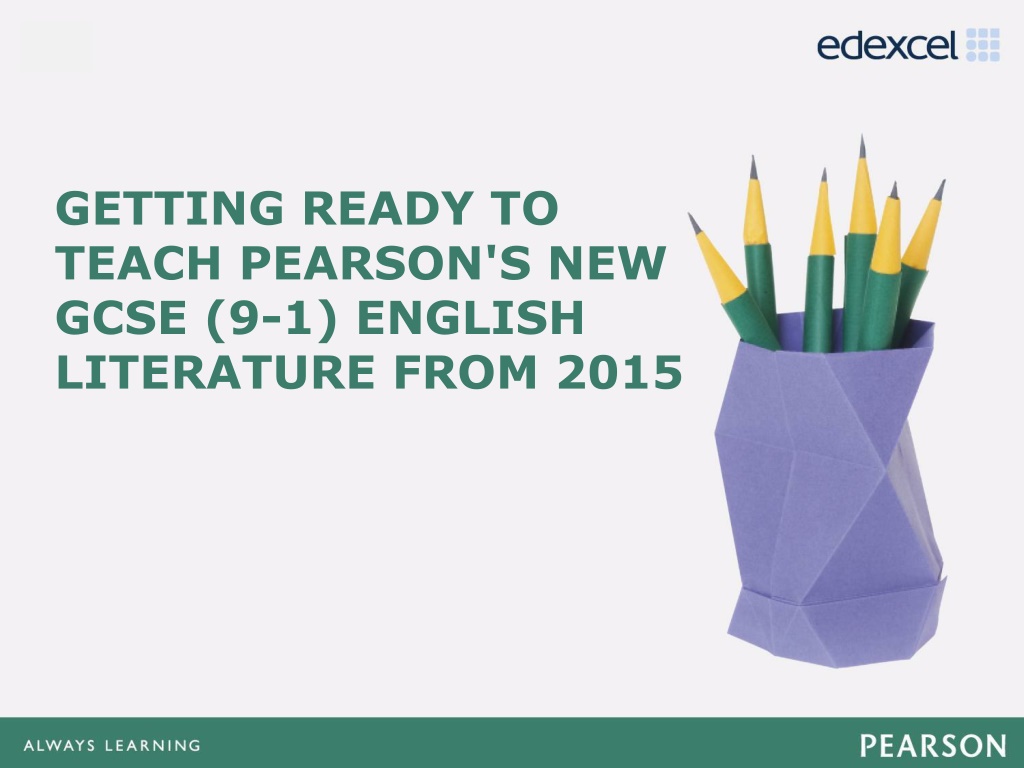
GCSE English Literature Exam Overview and Set Texts
Prepare for Pearson's new GCSE (9-1) English Literature exam focusing on Shakespeare, 19th-century fiction, poetry, and post-1914 British drama or prose. Explore the specified texts and exam requirements for Paper 1 and Paper 2, including analysis of set texts and poetry comparison. Get ready to ace your English Literature GCSE with this comprehensive guide.
Download Presentation

Please find below an Image/Link to download the presentation.
The content on the website is provided AS IS for your information and personal use only. It may not be sold, licensed, or shared on other websites without obtaining consent from the author. If you encounter any issues during the download, it is possible that the publisher has removed the file from their server.
You are allowed to download the files provided on this website for personal or commercial use, subject to the condition that they are used lawfully. All files are the property of their respective owners.
The content on the website is provided AS IS for your information and personal use only. It may not be sold, licensed, or shared on other websites without obtaining consent from the author.
E N D
Presentation Transcript
Click to edit Master title style GETTING READY TO TEACH PEARSON'S NEW GCSE (9-1) ENGLISH Click to edit Master text styles Second level Third level Fourth level Fifth level LITERATURE FROM 2015
Click to edit Master title style Click to edit Master text styles Second level Third level Fourth level Fifth level SPECIFICATION OVERVIEW
Changes to subject criteria Click to edit Master title style GCSE English Literature Click to edit Master text styles Second level Third level Fourth level Fifth level Poetry from 1789 including Romantic Poetry Shakespeare Students are also required to compare two unseen texts 4 set texts covering 19thCentury novel Post-1914 British prose or drama Closed book examination 5% SPaG Minimum examination time of 4 hours
GCSE English Literature Click to edit Master title style Paper 1 1 hr 45 mins (50%) Section A: Shakespeare Two questions One based on a 30-line extract and one on the whole play Paper 2 2 hrs 15 mins (50%) Section A: 19thCentury fiction Two questions One based on a 400-word extract and one on the whole novel Click to edit Master text styles Second level Third level Fourth level Fifth level Section B: Post-1914 British Drama or Prose Students study EITHER drama or prose Choice of essay questions SPaG is assessed Section B: Poetry One question comparing one named poem from the chosen anthology collection with another of the student s choice from the collection One question comparing two unseen contemporary poems
GCSE English Literature Click to edit Master title style Paper 1 Set Texts Section A: Shakespeare Macbeth The Tempest Romeo and Juliet Much Ado about Nothing The Merchant of Venice Twelfth Night Paper 2 Set Texts Section A: 19thCentury fiction Jane Eyre Great Expectations Dr Jekyll and Mr Hyde A Christmas Carol Pride and Prejudice Silas Marner Frankenstein Section B: Anthology poems 15 poems in each collection Click to edit Master text styles Second level Third level Fourth level Fifth level Section B: Post-1914 British Drama or Prose Animal Farm Lord of the Flies Anita and Me The Woman in Black (novel) An Inspector Calls Hobson s Choice Blood Brothers Journey s End Relationships Conflict Time and Place
GCSE English Literature Click to edit Master title style Assessment objective AO % in GCSE 37 Click to edit Master text styles Second level Third level Fourth level Fifth level support and illustrate interpretations AO2 Analyse the language, form and structure used by a writer to create meanings and effects, using relevant subject terminology where appropriate AO3 Show understanding of the relationships between texts and the contexts in which they were written AO4 Use of vocabulary and sentence structures for clarity, purpose and effect, with accurate spelling and punctuation AO1 Read, understand and respond to texts Students should be able to: maintain a critical style and develop an informed personal response use textual references, including quotations, to 42 16 5
Click to edit Master title style Click to edit Master text styles Second level Third level Fourth level Fifth level PAPER 1 - SHAKESPEARE
Click to edit Master title style Paper 1 Section A Shakespeare The question has two compulsory parts. Part a) is a close analysis of an extract which will be approximately 30 lines in length. Click to edit Master text styles Second level Third level Fourth level Fifth level Part b) is focused on how a theme from the extract is explored elsewhere in the play. Candidates also consider the context of the play. Part a) is assessed for AO2 (20 marks). Part b) is assessed for AO1 and AO3 (20 marks).
Click to edit Master title style Textual references and quotation Click to edit Master text styles Second level Third level Fourth level Fifth level
Text and Context (AO3) Click to edit Master title style Click to edit Master text styles Second level Third level Fourth level Fifth level
Exemplar extract Macbeth part a) Paper 1 Q1a: Explore how Shakespeare presents the character of Click to edit Master title style Lady Macbeth as being in control in this extract. Refer closely to the extract in your answer. Click to edit Master text styles Second level Third level Fourth level Fifth level macbeth it shows you that she is angrey with macbeth because macbeth has just killed Duncan and is ashamed of it and scared. This is a direct quote "I am afraid to thing what I have done" This quote shows that he is scared of what he has done and that is what he and lady macbeth are arguing about also it shows you that lady macbeth is shouting at macbeth Quote "infirm of purpose! In this extract from macbeth Act 2 Scene 2 there is an argument between macbeth and lady macbeth, and it asks you how does shakespeare represent lady
Exemplar extract Romeo and Juliet Click to edit Master title style - Part b 3b) Explain the importance of revenge elsewhere in the play . Click to edit Master text styles Second level Third level Fourth level Fifth level true love Romeo. Mercutio was protecting Romeo from Tybalt before he died, this could have made Romeo feel as though it was his duty to get revenge. As Mercutio is dying he says 'A plague a both your houses', this means he blames both the Montagues and Capulets for his death add wishes bad things on them. In those days, curses were taken very seriously and everyone is shocked when Mercutio says this three times. This could also be seen as revenge, as he has basically given bad luck to both families and cursed them Juliet talks of revenge when she is grieving for Tybalt, this is bad as if she pursues the revenge she may lose her
Click to edit Master title style Click to edit Master text styles Second level Third level Fourth level Fifth level PAPER 1 POST-1914 PROSE OR DRAMA
Click to edit Master title style Paper 1: Section B Post 1914 Drama or Prose Click to edit Master text styles Second level Third level Fourth level Fifth level Each question will be preceded by a short quotation from the text, to provide a stimulus for the response. Questions will focus on one or more of the following areas: plot, setting(s), character(s) and theme(s), and will require students to explore the question in relation to the context. A01, A03 and AO4 are assessed 40 marks Students complete one essay question from a choice of two on their text.
Vocabulary, sentence structure, Click to edit Master title style spelling (AO4) Click to edit Master text styles Second level Third level Fourth level Fifth level
Exemplar extract - An Inspector Click to edit Master title style Calls Paper 1 Q8 In what ways is Eva Smith exploited in the play? Click to edit Master text styles Second level Third level Fourth level Fifth level the factory. The play is set in 1914, before women's rights movement so women like Eva Smith and her co-workers would not be paid the same as a man who worked as hard as they did. Arthur Birling tells the inspector that he terminated Eva's employment because she had "too much to say", meaning he let her go because she incited protest at the exploitation of women at his factory In the play, we learn that Eva Smith lost her job for organising a protest against the low pay of women at
Exemplar extract - Animal Farm Paper 1 Q 15 Explore the significance of Boxer in Click to edit Master title style the novel Furthermore, Boxer is significant as he is a loyal member of the farm and ultimately leads to his death. His loyalty is shown through the way he obeys Napoleon and helps the windmill plans by actively building the windmill. Boxer's obedience towards Napoleon depicts his loyalty and he always defends Napoleon. His significance is due to the fact he never questions Napoleon's motives and trusts Napoleon. Boxer's loyalty leads to his death as he is a very gullible character. This quotation, '"Boxer!" cried Clover in a terrible voice...' further supports the idea that Boxer is gullible as he never realised his imminent death until Clover calls out to him. The reader ultimately feels sympathy for Boxer at this points and surprise because there was no reason why Napoleon ordered his death Click to edit Master text styles Second level Third level Fourth level Fifth level
Click to edit Master title style Click to edit Master text styles Second level Third level Fourth level Fifth level PAPER 2 19TH CENTURY FICTION
GCSE English Literature Click to edit Master title style Paper 1 1 hr 45 mins (50%) Section A: Shakespeare Two questions One based on a 30-line extract and one on the whole play Paper 2 2 hrs 15 mins (50%) Section A: 19thCentury fiction Two questions One based on a 400-word extract and one on the whole novel Click to edit Master text styles Second level Third level Fourth level Fifth level Section B: Post-1914 British Drama or Prose Students study EITHER drama or prose Choice of essay questions SPaG is assessed Section B: Poetry One question comparing one named poem from the chosen anthology collection with another of the student s choice from the collection One question comparing two unseen contemporary poems
Paper 2 Section A 19th Click to edit Master title style Century Click to edit Master text styles Second level Third level Fourth level Fifth level
Exemplar extract - Jekyll and Hyde Click to edit Master title style part a Paper 2 Q3a) Explore how Stevenson presents the atmosphere of Victorian London in this extract. Click to edit Master text styles Second level Third level Fourth level Fifth level morning as this. A sense of foreboding is created as Utterson makes his Journey to Mr Hyde's house. Utterson views the scene and considers it 'like a district of some city in a nightmare'. The use of simile emphasises the fact that the scene is one of horror and discomfort. Victorian London is not a nice place to be, especially on such a horrific In the second paragraph, the street is described and it shows the reader the poverty seen in London at the time. Stevenson describes the street as 'dingy', which suggests it is both dirty and run down. He then goes on to list other sights, such as 'a gin palace', which would not have been a 'palace' at all, but some establishment of ill- repute where one would expect to see those who had over-indulged and drunkards littering the street, even at this early hour
Exemplar extract - Jekyll and Hyde Click to edit Master title style part b Paper 2 Q3b) Explain why the setting is important elsewhere in the novel ...There are other settings in the novel, such as Utterson's, Lanyon's and Jekyll's houses. Each of these homes are described as being comfortable, which is in sharp contrast to the settings outside. Jekyll's house is described as being 'handsome', suggesting his wealth and success. When Utterson and Inspector Newcomen go to Hyde's house, the furniture is described in detail and the rooms are tastefully decorated. The reader gets a clue that Jekyll has provided most of the contents. The room is untidy, with clothes thrown everywhere and evidence burned, which confirms Hyde's guilt in both Utterson and Newcomen's minds, especially as part of the broken stick was there Click to edit Master text styles Second level Third level Fourth level Fifth level
Paper 2 Section B Poetry Click to edit Master title style Anthology poetry: Part 1: students answer one question on one named poem from the poetry anthology collection, reproduced in the question paper, and one poem of their choice. Students will compare the poems. Questions will focus on the language, form and structure of the poem and the contexts in which the poems were written. AO2 and AO3 will be targeted. 20 Marks Click to edit Master text styles Second level Third level Fourth level Fifth level
Paper 2 Section B Poetry Click to edit Master title style Unseen Poetry Part 2: students answer one question comparing two unseen contemporary poems that are linked by a theme. Students are required to compare the poets portrayals of the theme through their use of language, form and structure Click to edit Master text styles Second level Third level Fourth level Fifth level AO1 and AO2 will be targeted. 20 marks
GCSE English Literature Click to edit Master title style comparison Comparison requirement there is a requirement that 20%- 25% of the marks for this qualification are achieved through comparison questions across AO1, AO2 and AO3. The table below illustrates how these marks are allocated. Click to edit Master text styles Second level Third level Fourth level Fifth level AO Assessment objective % in GCSE 9.5 AO2 Anthology poetry (Component 2, section B, part 1) AO3 Anthology poetry (Component 2, section B, part 1) 3 AO1 Unseen Poetry (Component 2, section B, part 2) 5 AO2 Unseen Poetry (Component 2, section B, part 2) 7.5
Comparison - anthology poems Click to edit Master title style Instructions to examiners Click to edit Master text styles Second level Third level Fourth level Fifth level The coverage of the two poems need not be equally weighted but the second poem should have substantial treatment. Responses that are considerably unbalanced will not be able to access Level 3, where explanation of writers ideas and perspectives is required alongside a wide range of comparisons between texts. In responses to Questions 8, 9, and 10, examiners should be aware of the different ways candidates may structure their responses. There should be sufficient evidence of a response comparing the poems. Candidates are free to select and comment on textual details in a variety of ways. They are not expected to deal with every possible point and may be rewarded for a comparatively small number of points if they are effectively developed and supported by well-chosen textual evidence.
Exemplar extract - Anthology Poetry Conflict Click to edit Master title style Paper 2 Q9 Compare how tension is presented in the two poems Click to edit Master text styles Second level Third level Fourth level Fifth level structured in two sections - 'Catrin' is about two times when conflict and tension have been present in the mother and daughter relationship. 'What Were They Like?' has the questions and answers, although the poem can be read in different ways. The poets use similar language techniques in order to express their ideas, such as metaphors and alliteration. In 'Catrin', there are no direct questions, but in the second stanza a question creates tension "As you ask may you skate in the dark", whereas in 'What Were They Like?', questions are used to structure the poem Both poems are similar because they convey tension, but they are different because one refers to family tension between two people, but the other is about the tension caused by war and its effect on a whole country and its people. Both poems are
Comparison - unseen poems Click to edit Master title style Instructions to examiners Click to edit Master text styles Second level Third level Fourth level Fifth level Responses that are considerably unbalanced will not be able to access Level 3, where explanation of the writers ideas and perspectives is required alongside a wide range of comparisons between texts. In responses to Question 11, examiners should be aware of the different ways candidates may structure their responses. There should be sufficient evidence of a response comparing the poems. Candidates are free to select and comment on textual details in a variety of ways. They are not expected to deal with every possible point and may be rewarded for a comparatively small number of points if they are effectively developed and supported by well-chosen textual evidence.
Exemplar extract - Unseen Click to edit Master title style poetry Paper 2 Q11 Compare the ways the ways the writers present an old person in Great Grandfather and On the Verge. Within both poems they both share the same theme, the comparison of an elderly person. However the ideas in both poems contrast. Click to edit Master text styles Second level Third level Fourth level Fifth level For example, 'On the Verge', written by Michael Ware is the physical description of a person aging. 'The skin is wrinkled and speaks of age'. The skin is personified to speak of age. The fact he implies the skin is wrinkled we already assume it is aged. It speaks of its age the idea of aged appearance is repeated, on the first line, so the reader already visually pictures the man. This contrasts with 'Great-grandfather', written by Freda Downie. Within Great-grandfather it is not the elderly man who is physically described but his dated surroundings and the fact he is a great-grandfather that give the reader an insight of his age
Click to edit Master title style Click to edit Master text styles Second level Third level Fourth level Fifth level SUPPORT
Supporting you through the changes Click to edit Master title style Click to edit Master text styles Second level Third level Fourth level Fifth level Personal support Tracking progress Training from Pearson Planning and delivery Teaching and learning Understanding the standard
Understanding the standard Click to edit Master title style We will provide you with information and support to help you understand the standard: Comprehensive banks of exemplar student work and examiner commentaries derived from our trialling with centres Click to edit Master text styles Second level Third level Fourth level Fifth level Extensive training for all units Mark schemes that have been researched and trialed Additional sample papers Training on delivering units and marking mocks Local network groups Subject advisor
The website Click to edit Master title style Click to edit Master text styles Second level Third level Fourth level Fifth level
Planning and delivery Click to edit Master title style We will provide you with the best support: Click to edit Master text styles Second level Third level Fourth level Fifth level a Getting Started guide with detailed guidance a range of course planners, outlining different delivery approaches an editable scheme of work to save you time KS3 preparation tests Poetry anthology with free teaching and learning resources support packs for new topic areas.
Planning and SoW Click to edit Master title style Option for a 2 year plan year 10 Click to edit Master text styles Second level Third level Fourth level Fifth level Autumn 2 Reading and Writing skills Year 10 Language Literature Autumn 1 Intro to Language AOs Intro to Literature AOs Shakespeare play Spring 1 AO3 comparison writing skills Post-1914 text introduction Spring 2 Mock exam Post-1914 text reading the whole text Summer 1 Reading Skills 19th century. 19th-century text Summer 2 Imaginative writing Introduction to poetry anthology and unseen
Planning and SoW Click to edit Master title style Option for a 2 year plan year 11 Click to edit Master text styles Second level Third level Fourth level Fifth level Autumn 2 Year 10 Language Literature Autumn 1 Reading and Writing non- fiction Poetry Revisit Shakespeare play Spring 1 Revise Language Paper 1 Revise Literature Paper 1 Spring 2 Revise Language Paper 2 Revise Literature Paper 2 Summer 1 Revision focus on timings and SAMs Exam Revision focus on timings and SAMs Exam Summer 2
Click to edit Master title style Poetry Anthology ActiveTeach Click to edit Master text styles Second level Third level Fourth level Fifth level Worksheets, audio recordings and additional assets Guidance on context and help preparing students for comparison requirements Includes additional lessons covering prep for comparison requirements and a unit on preparing for the unseen poetry Available NOW online via ActiveTeach, for front- of-class use or easy download Free teaching and learning resource to help you as you teach the Poetry Anthology Lesson plan for each poem will include:
Click to edit Master title style Poetry Anthology ActiveTeach Text on screen, with links to all resources, including audio Click to edit Master text styles Second level Third level Fourth level Fifth level Detailed lesson plans for each poem
KS3 Support GCSE-style Click to edit Master title style assessments We are providing GCSE-style assessments opportunities for KS3 End of year assessments in years 7, 8 and 9 in both Language and Literature Baseline assessment for the start of year 7 in both Language and Literature One free unit of Grammar for Writing for Y9 Click to edit Master text styles Second level Third level Fourth level Fifth level
KS3 Support GCSE-style Click to edit Master title style assessments Click to edit Master text styles Second level Third level Fourth level Fifth level appropriate for the year group, with relevant skills/AOs assessed at the appropriate level The KS3 GCSE-style assessments will: Will progress towards the format of the GCSE exams Focus on ensuring the level of the assessment will be Be linked to the Pearson Progression Steps to help you to track progress Move towards being assessed using the GCSE mark scheme Be paper-based, downloadable, printable question papers and mark schemes
Click to edit Master title style Let s Think in English Click to edit Master text styles Second level Third level Fourth level Fifth level Pedagogy underpinned by a research trial Helps students develop thinking skills necessary for success in English In partnership with Kings College London Teaching programme developed by a team at Kings College London Builds skills of inference, deduction and analysis Builds confidence in unseen texts in exams Lessons are based on discussion, problem solving and structured reflection
Lets Think in English Free Click to edit Master title style lessons Free support to put the pedagogy into practice 5 free lessons Click to edit Master text styles Second level Third level Fourth level Fifth level Lessons based on text types for the new GCSEs: Lesson plans, Powerpoints, Worksheets, other assets Developed, trialled and reviewed by Kings College London 19thcentury fiction 20thcentury literary non-fiction Modern direct non-fiction Romantic poetry Shakespeare Available NOW online via ActiveTeach, for front- of-class use or easy download
Click to edit Master title style Let s Think in English Click to edit Master text styles Second level Third level Fourth level Fifth level Lesson plan, PowerPoints and worksheets can be downloaded or launched straight from the website
Endorsed resources Click to edit Master title style We are committed to helping teachers deliver our Edexcel qualifications and students to achieve their full potential. Click to edit Master text styles Second level Third level Fourth level Fifth level To do this, we aim for our qualifications to be supported by a wide range of high-quality resources, produced by a range of publishers, including ourselves. However, it is not necessary to purchase endorsed resources to deliver our qualifications. A list of all endorsed resources will be available on edexcel.com
Endorsed resources Click to edit Master title style We are working with a range of publishers who are Click to edit Master text styles Second level Third level Fourth level Fifth level Pearson looking towards getting their resources endorsed: ZigZag Education
Endorsed resources Click to edit Master title style Click to edit Master text styles Second level Third level Fourth level Fifth level Pearson Printed text book anthology; 6 tiered workbooks building reading and writing skills; Active Teach; assessment and revision resources. ZigZag Education Study guides and activity packs for Language and Literature. *These resources have not yet been endorsed. This information is correct as of January 2015, but may be subject to change.
Click to edit Master title style Professional Development Click to edit Master text styles Second level Third level Fourth level Fifth level Developed and delivered by teams at: University of Exeter King s College London Face-to-face training sessions to support you with the Grammar for Writing and Let s Think in English pedagogies
Click to edit Master title style Click to edit Master text styles Second level Third level Fourth level Fifth level CONTACT INFORMATION
Click to edit Master title style Contact information English Subject Advisor, Clare Haviland: Click to edit Master text styles Second level Third level Fourth level Fifth level http://www.edexcel.com/Subjects/English/Pages/Default.aspx teachingenglish@pearson.com Tel: 0844 372 2188 English forum look at and participate in: www.community.edexcel.com/english/default.aspx Twitter: www.twitter.com/EnglishSubAdv www.edexcel.com/learningforabetterfuture

